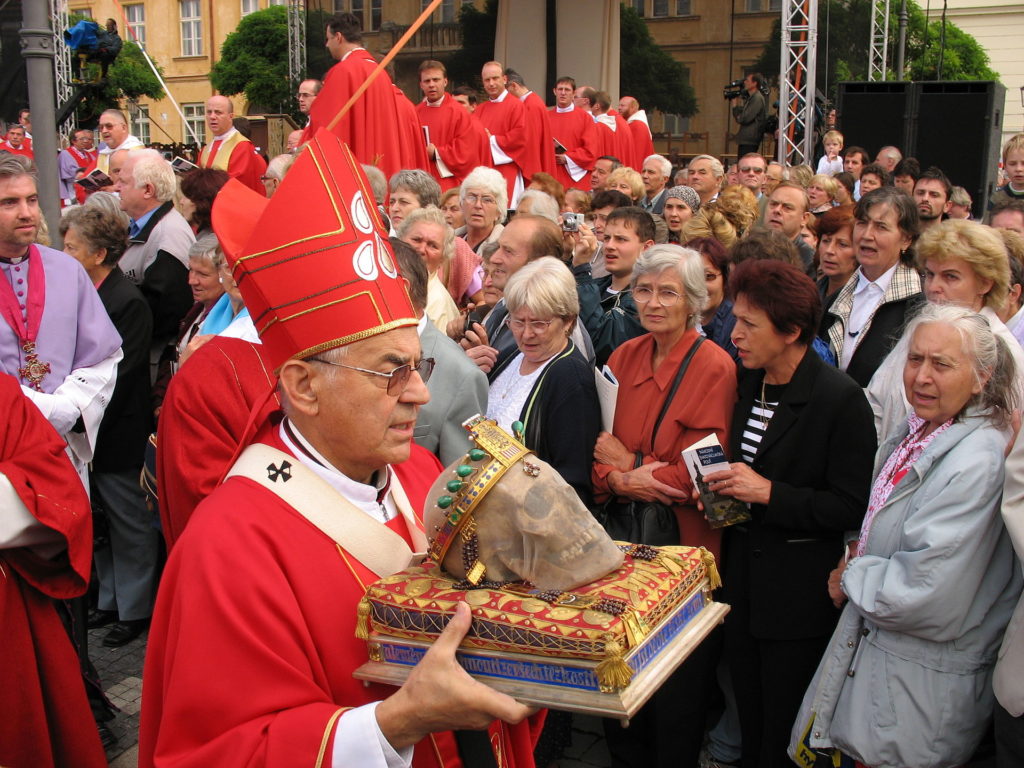One of the most famous monuments in the whole of Prague and perhaps the whole of the Czech Republic is the statue of St. Václav on Wenceslas (Václav) Square.
St. Václav is the patron of the Czech lands and the most popular saint here. Since the year 2000, September 28 has been a state holiday: the Day of Czech Statehood.
Most native English speakers are familiar with the Christmas carol “Good King Wenceslas”. The real Wenceslas, however, was never a king.
He was Duke of Bohemia, born circa A.D. 907. His father, Vratislav I, was a member of the long-reigning Přemyslid dynasty; his mother, Drahomíra, was the daughter of a tribal chief. Vratislav’s father, Bořivoj, was baptized by Saints Cyril and Methodius, missionary brothers from Greece who brought Christianity to the region of the Great Moravian Empire.
Saint Wenceslas – the patron saint of the Czech lands
Legends depict Wenceslas’s mother as a champion of paganism, against which stood the champion of Christianity Ludmila, whose role as the protector of the faith was later taken up by Wenceslas. He sat on the princely throne somewhere between 921 and 925. Wenceslas is depicted by legend as almost like a monk on the throne – as a virtuous ruler who bought slaves, destroyed the pagan temples and at the current Prague Castle, even grew grapes for the production of sacramental wine.
However, a power struggle eventually resulted in fratricide. In 935, Wenceslas was murdered by his younger brother Boleslav at the entrance to the church in his royal city – today’s Stará Boleslav.
After Wenceslas’s death, Boleslav assumed power and reigned for almost fifty years. Later in life, Boleslav felt remorse for his actions and in 972 he had a church devoted to Saint Wenceslas built in Prague.
How is it Celebrated?
The culmination of the celebrations of St. Wenceslas is a solemn Mass in the church of St. Wenceslas in Stará Boleslav, or the St. Wenceslas Cathedral. During this Mass, the relics of St. Wenceslas are exhibited, including the skull, on which rests a royal crown, a sign that he’s the perpetual hereditary prince of the Czech lands.
People repeatedly ask the saint in prayer for the intercession and protection of the Czech nation. Prayers can be summarized in the credo: “Saint Wenceslas, do not let us and our descendants perish.” Further, Czechs sing the hymn of St. Wenceslas, one of the oldest Czech songs at a thousand years old.

Cardinal Miloslav Vlk with the skull of Saint Wenceslaus during a procession on September 28, 2006
Prague is still closely linked with the St. Wenceslas tradition even today. The remains of the Czech prince are stored in the chapel of St. Vitus Cathedral and one of the oldest vineyards, dating back all the way to the 10th century, bears the name St. Wenceslas vineyard.
The unique place on the south slope near Prague Castle (Villa Richter area) can be enjoyed on September 28 with a glass of wine at the traditional grape harvest, where in addition to a number of tastings there will also be demonstrations of authentic manual presses.
Support Prague Morning!
We are proud to provide our readers from around the world with independent, and unbiased news for free.
Our dedicated team supports the local community, foreign residents and visitors of all nationalities through our website, social media and newsletter.
We appreciate that not everyone can afford to pay for our services but if you are able to, we ask you to support Prague Morning by making a contribution – no matter how small 🙂 .




